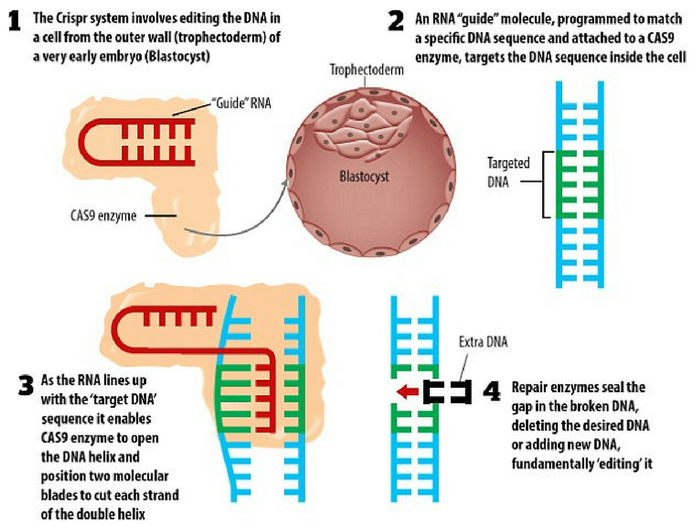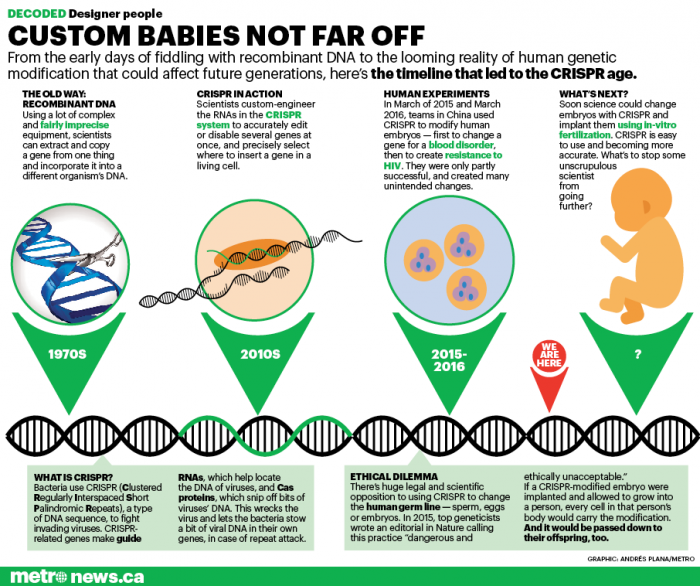Scientists Use CRISPR to Edit Human Embryos in U.S. for First Time

A group of scientists in Oregon have edited the genes of human embryos for the first time in the United States, using CRISPR-Cas9, a cut-and-paste gene-editing tool. [1]
The experiments were conducted by Shoukhrat Mitalipov and colleagues at Oregon Health & Science University in Portland. The single-celled embryos Mitalipov edited were discarded after the experiments to ensure they could not become too developed.
Live Science explains how the CRISPR/Cas9 gene-editing tool works:
“The CRISPR/Cas9 gene-editing system is a simple “cut and replace” method for editing precise spots on the genome. CRISPRS are long stretches of DNA that are recognized by molecular “scissors” called Cas9; by inserting CRISPR DNA near target DNA, scientists can theoretically tell Cas9 to cut anywhere in the genome. Scientists can then swap a replacement gene sequence in the place of the snipped sequence. The replacement sequence then gets automatically incorporated into the genome by natural DNA repair mechanisms.”

CRISPR was used by scientists in China in 2015 to edit several human embryos that had severe defects. Like the scientists in Oregon, the team in China discarded the embryos before they could become too developed.
The Chinese technique led to genetic changes in a few of the embryos, and in a few cases, CRISPR sometimes snipped out the wrong place in the DNA.
Mitalipov’s experiments were reportedly successful in that they edited far more embryos than scientists did in past research. Additionally, Mitalipov and his colleagues claim they managed to do so without causing as many errors as previous scientists. [2]
Someday – perhaps much sooner than we realize – scientists could use this technique to edit not just the offspring of people with genetic diseases, but their offspring, as well. Theoretically, this could eradicate diseases caused by mutated genes, such as Huntington’s, sickle-cell anemia, Tay-Sachs, and many others.
But it’s risky…
Gene-editing is rife with controversy and ethical concerns. While many say CRISPR-Cas9 will help reduce the occurrence of genetic diseases, Marcy Darnovsky, Executive Director of the Center for Genetics and Society, says there are ways to do that which don’t involve editing the human genome.
“This is just not needed for preventing inheritable disease. There are [other techniques that] can already be used safely to prevent the births of children with serious genetic diseases in almost every case.”
For example, preimplantation diagnosis (PGD) allows parents to screen embryos for certain disease-causing genes before implanting them via in-vitro fertilization (IVF). However, in cases where someone carries 2 copies of a defective gene, PGD won’t work because all their embryos would also carry that gene.
Read: Study: CRISPR Gene-Editing Ignites Tons Of Unintentional Genetic Mutations
Darnovsky is also greatly worried about the safety of CRISPR gene-editing. He said:
“Despite whatever the claims are about safety, [like] no mosaicism, we still don’t know if that would mean it’s safe to create a new human being and anyone who tried it would be taking an enormous and unacceptable risk with that future person’s life.”
Right now, scientists are supposed to focus their efforts on editing disease-causing genes. But CRISPR could potentially open the door to the creation of “designer babies,” in which parents are permitted to edit their children to be better at sports or math, for example, or to be more physically attractive.

Darnovsky explained:
“That would be layering new forms of inequality and discrimination onto the ones we already live with.”
He’s not alone in his concerns.
In 2016, the U.S. intelligence community called CRISPR a potential “weapon of mass destruction.” [3]
Sources:
[1] Live Science
[2] Mother Jones
Metro News
